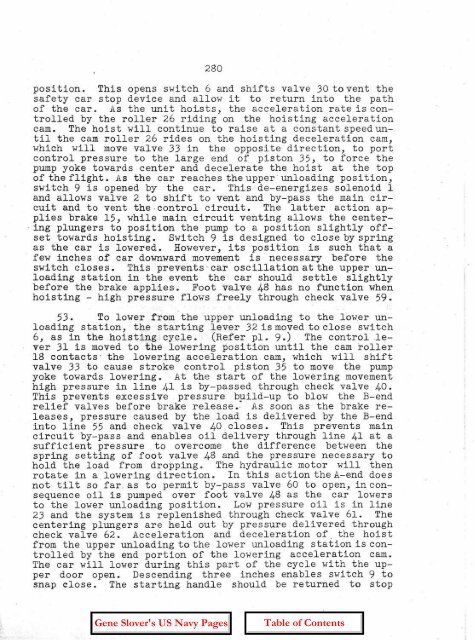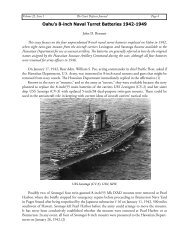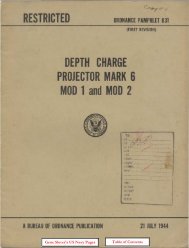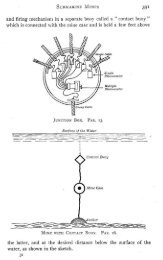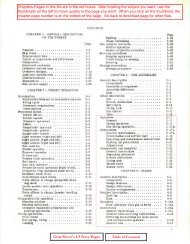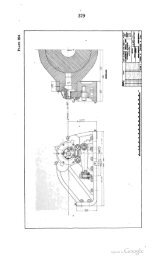OP-755 Part 2 Pages 197-401 - Personal Page of GENE SLOVER
OP-755 Part 2 Pages 197-401 - Personal Page of GENE SLOVER
OP-755 Part 2 Pages 197-401 - Personal Page of GENE SLOVER
Create successful ePaper yourself
Turn your PDF publications into a flip-book with our unique Google optimized e-Paper software.
280<br />
position. This opens switch 6 and shifts valve 30 to vent the<br />
safety car stop device and allow it to return into the path<br />
<strong>of</strong> the car. As the unit hoLst s , the acceleration rate is controlled<br />
by the roller 26 riding on the hoisting acceleration<br />
cam. The hoist will continue to raise at a constant speed until<br />
the cam roller 26 rides on the hoisting deceleration cam,<br />
which will move valve 33 in the opposite direction, to port<br />
control pressure to the large end <strong>of</strong> piston 35, to force the<br />
pumpyoke towards center and decelerate the hoist at the top<br />
<strong>of</strong> the flight. As the car reaches the upper -1inloading position,<br />
switch 9 is opened by the car. This de-energizes solenoid 1<br />
and allows valve 2 to shift to vent and by-pass the main circuit<br />
and to vent the control circuit. The latter action applies<br />
brake 15, while main circuit venting allows the center-<br />
-ing plungers to position the pump to a position slightly <strong>of</strong>fset<br />
towards hoisting. Switch 9 is designed to close by spring<br />
as the car is lowered. However, i tsposi tion is such that a<br />
few inches <strong>of</strong> car downwardmovement is necessary before the<br />
switch closes. This pre-v-ents-car oscillation at the upper unloading<br />
station in the event the car should settle slightly<br />
befo:re the brake applies-. Foot valve 48 has no function when<br />
hoisting - high pressure flows freely through check valve 59.<br />
53. To lower from the upper unloading to the lower unloading<br />
station, the starting lever 32 is movedto close switch<br />
6, as in the 40isting4cycle. (Refer pl. 9.) The contr611~ver<br />
31 is moved to the lowering position until the cam roller<br />
18 contacts - the lowering acceleration carn, which will shift<br />
valve 33 to cause stroke - control piston 35 to move the pump<br />
yoke towards lowering. At the start <strong>of</strong> the lowering movement<br />
high pressure in line 41 is by-passed through check valve 40.<br />
This prevents excessive pressure b!lild-up to blow the B-end<br />
relief valves before brake release. As soon as the brake releases,<br />
pressure caused by the load is delivered by the B-end<br />
into line 55 and check valve 40 closes. This prevents main<br />
circuit by-pass and enables oil delivery through line 41 at a<br />
sufficient pressure to overcome the difference between the<br />
spring setting <strong>of</strong> foot valve 48 and the pressure necessary to<br />
hold the load from dropping. The hydraulic motor will then<br />
rotate in a lowering direction. In this action theA-end does<br />
not tilt so far as to permit by-pass valve 60 to open, inconsequence<br />
oil is pumped over foot valve 48 as the car lowers<br />
to the lower unloading position. Low pressure oil is in line<br />
23 and the system is replenished through check valve 61. The<br />
centering plungers are held out by pressure delivered through<br />
check valve 62. Acceleration and deceleration <strong>of</strong> _the hoist<br />
from the upper unloading to the lower unloading station is controlled<br />
by the end portion <strong>of</strong> the lowering acceleration cam.<br />
The car will lower during this part <strong>of</strong> the cycle with the upper<br />
door open. Descending three inches enables switch 9 to<br />
snap eLose . The starting handle should be returned to stop


